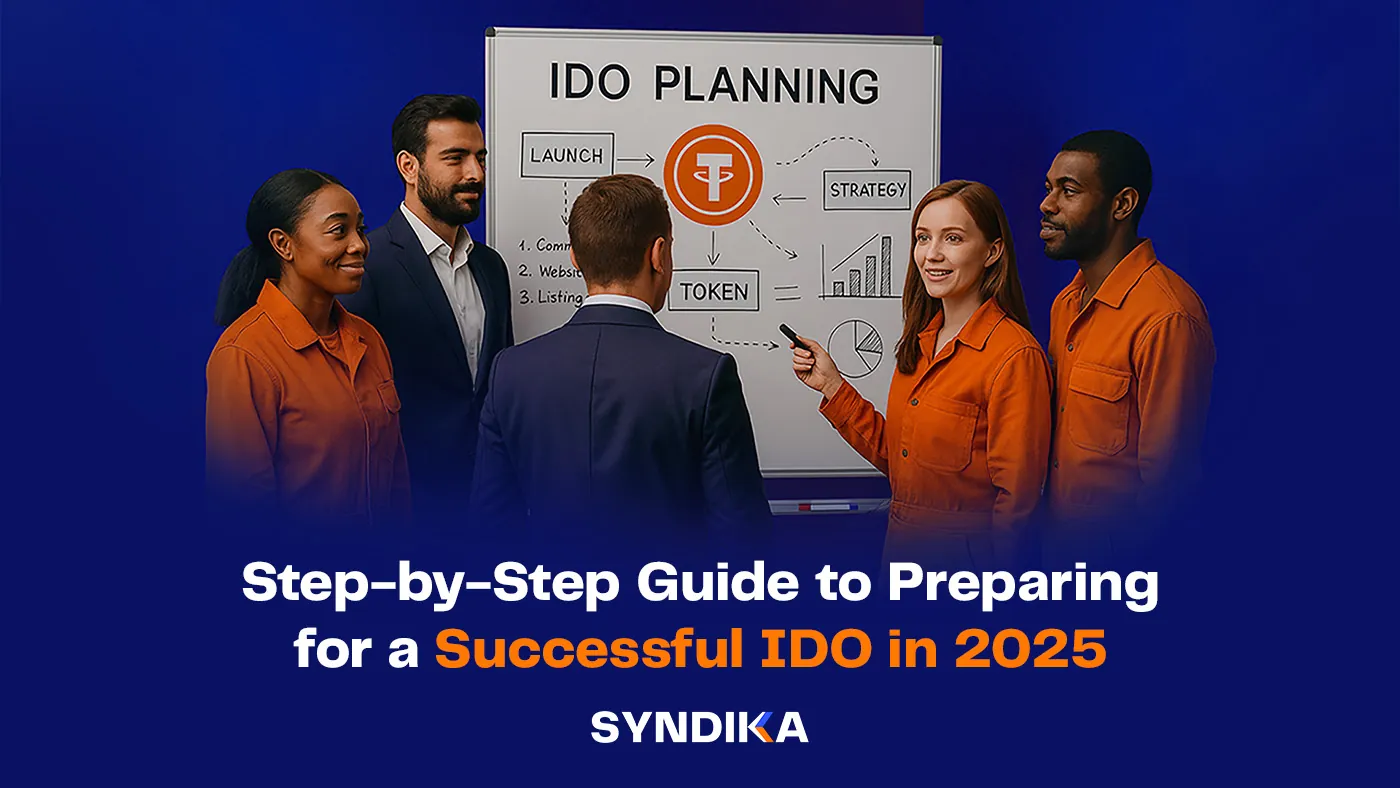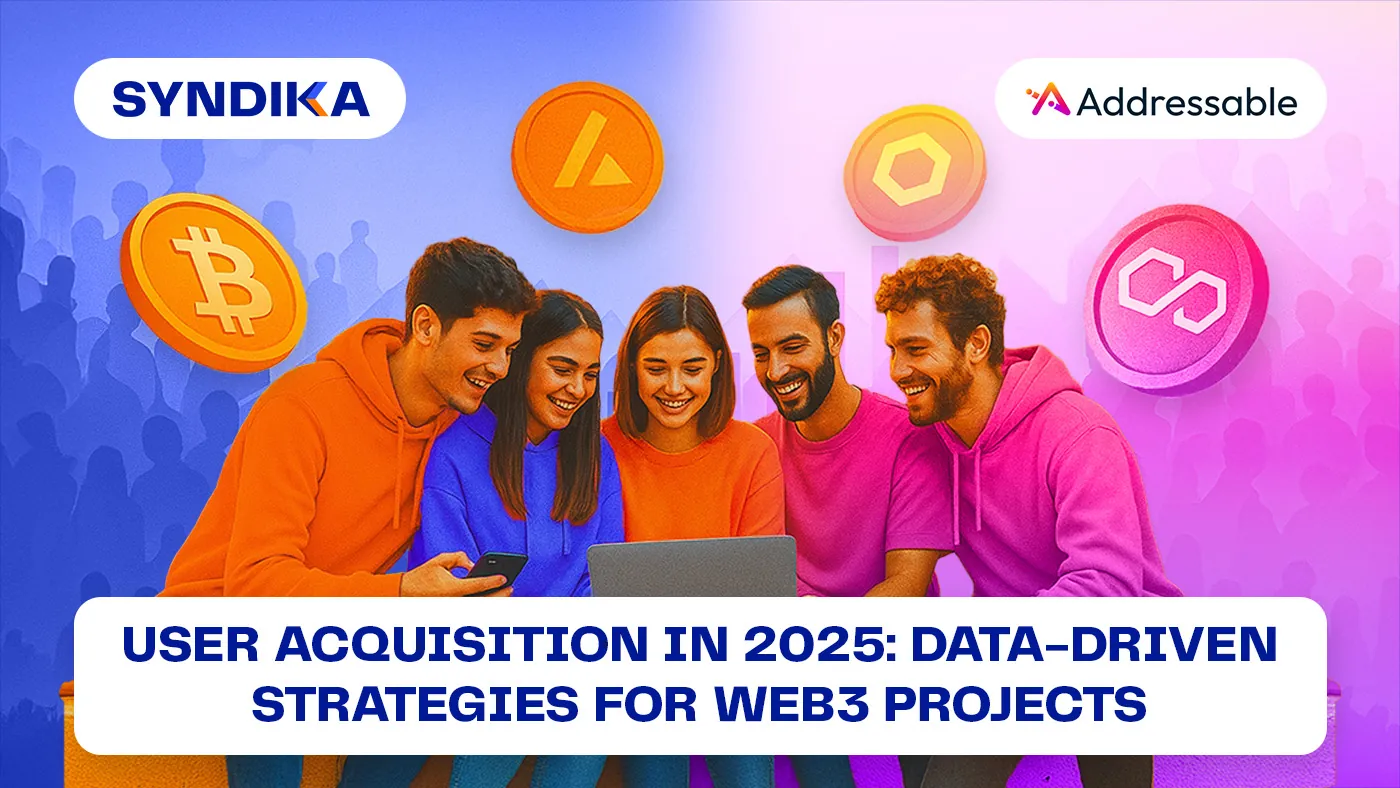
Before a crypto project launches a token, an IDO usually takes place. In a Web3 ecosystem, preparing for an IDO is just as important as the token launch itself, because execution around the IDO often determines whether your token gains traction or gets lost in the noise.
According to Bitcoin Insider, total crypto fundraising—including venture rounds, token sales, and M&A—reached $16.5 billion in the first half of 2025, surpassing all of 2024’s total count of $12.2 billion
A successful IDO isn’t just about launching a token—it’s about executing a coordinated go-to-market strategy that aligns with your crypto product, token, community, and liquidity.
Together with our partner, Klink Finance, we have prepared a step-by-step guide highlighting what Web3 founders should consider while planning an IDO listing in 2025.
1. Finalize Your Tokenomics with Real Market Data
In Web3, before you even think about launching, your tokenomics should be finalized—not just on paper, but with inputs from real market data, test simulations, and advisor feedback. Many Web3 startups design token supply and emissions curves without accounting for liquidity incentives or market maker behavior post-launch.
Before listing your token on an IDO platform, you need to clearly define why your token exists and how it drives value across your ecosystem. Work with tokenomics advisors to model the LP incentives, staking APRs, and treasury runway before minting your first token. Without real data your tokenomics is just theory that drives no user engagement.
“At Klink Finance, we’ve seen blockchain projects fail because they ignored liquidity modeling. Real data – not optimistic projections – should drive your tokenomics decisions.” – Gasper Stih, CMO at Klink Finance.
2. Build Your Community Incentive Engine Early
One more important thing that should go in hand with your tokenomics design is your community growth. Before your IDO, you should design and test your community incentive system.
2025 communities expect more than airdrops. Consider using tested quest platforms like Layer3 or Galxe for pre-IDO quests tied to real engagement. Structure incentives to reward not just invites, but retention, content creation, and eventually on-chain activities.
As practice shows, blockchain projects with engaged communities at TGE often outperform on volume and liquidity, because buyers see traction.
3. Lock in Your Market Maker Before Launchpad Selection
Many launchpads now require a signed agreement with a market maker before approval. This isn’t just about listing support — it’s about reputation.
Negotiate terms with your chosen crypto market maker early. Ask about delta-neutral strategies, liquidity thresholds, and CEX reach. Ensure they have experience with tokens in your size and narrative. You can check out the list of the top crypto market makers by Syndika here.
At the end of the day, top market makers don’t just take spreads—they help projects manage liquidity, bots, and volatility.
4. Stress-Test Liquidity and Treasury Strategies
Token price volatility often stems not from market conditions alone, but from poor treasury planning and reactive liquidity management. Before launch, run worst-case simulations for token sales, buybacks, and LP provisioning across different market conditions.
You need clear, quantitative answers to questions such as:
– How much liquidity will you own post–TGE?
– Who controls the LP tokens?
– What happens if your token drops 40% in the first month? Can you still execute your roadmap in that case?
– Do you have enough stablecoin or runway to continue building for the next 12–18 months, regardless of market performance?
Buyers and partners want to see a treasury plan that can survive bear moves, not just pump cycles.
5. Prepare Your Token for Regulatory Screens and Undergo Security Audits
In Web3, regulatory compliance is no longer optional; it’s a prerequisite for getting listed on reputable launchpads and decentralized or centralized exchanges. Depending on your jurisdiction and target markets, your token may be subject to pre-launch screening by exchanges, regulators, and compliance partners. This preparation should include:
- Privacy and sanctions screening for Web3 founders and early investors
- Investor accreditation workflows for private rounds (especially in the U.S. and EU)
- Disclosure readiness for tax reporting, legal classification, and financial audits
- KYC/AML infrastructure, especially if your launchpad or exchange enforces it (tools like Synaps, Blockpass, and Fractal ID are common choices)
Failing to meet compliance standards can lead to delistings, blocked jurisdictions, or retroactive legal risk. That’s why it’s essential to design with privacy-enhancing technologies (PETs) and compliance in mind from the start.
You can learn about the privacy-enhancong technologies in our joint post with Partisia Blockchain here.
6. Warm Up Your Exchange Relationships
Getting listed post-IDO—on a centralized exchange or aggregator—is the next step after you get listed on an IDO platform. Thus, you’d better start these conversations 2–3 months before your TGE.
Most exchanges conduct detailed due diligence before listing. As a Web3 startup, be prepared to answer questions about your:
- Team identity and track record
- Tokenomics, including supply, unlocks, and utility
- Smart contract audits and security measures
- Liquidity provisioning plans, including sources and lockups
- Compliance readiness, especially for KYC/AML and legal structure
- Roadmap and long-term ecosystem strategy
You can learn more about token launch preparation here.
7. Choose Your Launchpads and Design the Rollout
Start by mapping your token profile (utility, audience, and region) to launchpads that can amplify your reach. Ask yourself these questions:
- Does the platform attract your ideal users?
- Is it integrated with the chains or ecosystems you plan to build on?
- Can it support KYC, vesting mechanics, or regulatory controls as needed?
In 2025, many Web3 founders run multi-launchpad strategies—splitting token allocations across geographies, chains, or user segments
When choosing your crypto launchpad or IDO platform, detail how the sale will unfold: What is the allocation breakdown across sale phases? How will whitelist eligibility be determined? What’s the exact timeline and flow of the sale?
Learn more about the “Top Crypto Launchpads and IDO Platforms to Watch in 2025” in this article.
8. Prepare Investor-Facing Materials Early
Before your IDO listing, your investors will need more than your pitch deck. Prepare a full data room for your investors with:
- A one-pager or lightpaper
- Tokenomics PDF with clear charts and logic
- Audit reports and legal memos (if available)
- Roadmap
- TGE info
A clean, professional data room not only improves investor confidence—it also helps partners and launchpads perform faster due diligence.
“In Klink’s experience, investor trust skyrockets when you’re transparent early. A clear data room signals you’re serious and ready for institutional interest,” confirms Gasper Stih, CMO at Klink Finance.
9. Prepare Post-TGE Utility and Adoption Campaigns
Once the TGE is complete and your IDO goes live, you must immediately drive real on-chain utility and engagement. Don’t let your TGE be the peak of attention.
Use airdrop campaigns to drive token usage in the first 90 days. Plan early for token-based interactions such as staking, in-app payments, governance participation, etc. Leverage platforms like Zealy, Galxe, Layer3, or custom dApps to design gamified quests and participation incentives that reward real usage over speculation.
The plan is not just to launch your TGE and IDO campaigns but also to retain your users and buyers who come with the TGE/IDO.
“At Klink, we’ve seen tokens that launch with no immediate utility fade quickly. The first 90 days are critical – users must have a reason to hold, stake, and use your token beyond speculation,” believes Gasper.
10. Launch and Monitor with a 90-Day Post-IDO Plan
The IDO is only the starting point for public trading—what happens next determines your token’s staying power. A 90-day plan to monitor usage, liquidity, and community growth shows investors that you can deliver results, not just hype.
Thus, track exact, quantifiable KPIs:
- Token holder retention – How many wallets still hold tokens after 30, 60, 90 days?
- Liquidity depth and slippage – What is the average depth across key pairs? What’s the slippage at $10k, $50k, $100k trades?
- On-chain usage – How many transactions are made using your token? How many unique wallets interact with your dApp or staking contracts?
- Community engagement – How many new users join your channels weekly? What’s your DAU/MAU ratio across community platforms or apps?
Your investors and partners don’t just want vision—they expect evidence.
Bottom Line
In Web3, a successful IDO isn’t just a technical launch—it’s a holistic fundraising campaign that spans legal, economic, community, and liquidity strategy.
Crypto projects that approach their IDO with the discipline of a startup—backed by data, tested assumptions, and long-term thinking—stand out from the noise. The winners aren’t just launching tokens; they’re building ecosystems designed to grow, adapt, and deliver real value from day one.
Disclaimer: This article is not financial or legal advice. Always do your own research and consult professionals before proceeding with any token launch.



